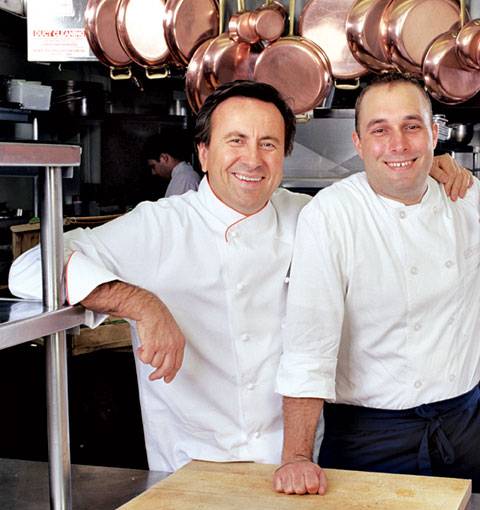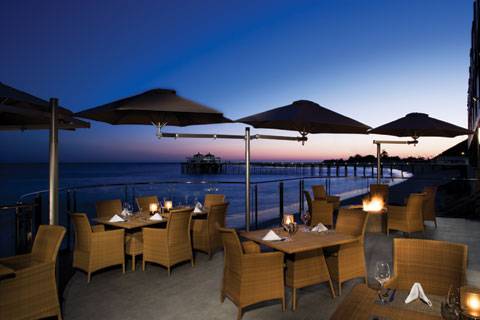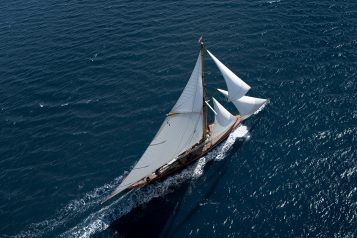Panerai’s Angelo Bonati discusses the winding path to building a timeless brand.
By Laura Perlongo
Photography by Bob Martus
Long before Bonati got his hands on the largely unknown brand, Panerai was building an extensive background that would later legitimize its place in history.
What do Bill Clinton, Heidi Klum, Wolfgang Puck, and the majority of top NFL players have in common? Large bank accounts, sure. But there are also the giant, luminous ticking wonders adorning their wrists. And, on any of these famous power players, chances are, it’s a Panerai. Despite gracing the arms of diplomats and celebrities alike, the path to becoming the most revered watch brand in the luxury market has been long for Officine Panerai. More than 100 years in the making, the Italian brand’s story winds more than a grandfather clock. Yet, through the years, Panerai has proved itself a timeless symbol of cutting edge technology and design, quality, and exclusivity.
Largely responsible for the watch-brand turned legend is Angelo Bonati, chairman of Officine Panerai. With both the passion and talent to make a virtually unknown timepiece go down in history as one of the fastest growing, most respected brands, he radiates classic luxury from head to toe. Bonati grins as he strolls into our interview and asks for a coffee. From his calm demeanor and well-tailored look (complete with a special edition Panerai), one could never guess he is straight off a red-eye from Italy, jet-lagged with lost luggage to boot. Quickly remembering where he is-realizing it’s American coffee-he rescinds his beverage request with a laugh.
Growing up in a traditional, no-nonsense Italian family, Bonati always knew there was something abnormal about his interests. “I was always attracted by what was nice, what was beautiful or ornate. Because it is an expression of art, not just business,” Bonati explains. “When I take an object in my hands, I don’t think what does it cost or how much money can it make, I think, ‘Is this object beautiful? Is it comfortable?'”
Panerai is far from Bonati’s first rendezvous with a luxury brand. Once the president of Cartier Italy, he worked with Vendome and stepped into some of the most esteemed fashion houses. Bonati’s extensive experience with luxury products and innate instinct for beauty gave him the ability to turn the Panerai brand from a cult-like collector’s piece into the well-known, fiercely-sought watch of modern times. A seemingly impossible feat, it was Bonati’s competitive spirit that lured him to the unknown brand. “Panerai was not an entity. It was nothing. I did have another opportunity with a well-known luxury brand and the Panerai salary was much lower, but I was so attracted to the challenge. The challenge for me is very important,” he beams.
Long before Bonati got his hands on the largely unknown brand, Panerai was building an extensive background that would later legitimize its place in history. Founded in 1860, it was not until more than 100 years later that Panerai watches became available to the public. The Italian company’s founder, Giovanni Panerai, was the first watchmaker in Florence, but the zeitgeist of the times during WWI demanded he refocus the company’s efforts on building a variety of precision instruments for the Royal Italian Navy. With compasses, depth gauges, and yes, even watches, the engineering company strictly provided a military service. Their first watch was the Radiomir Black Seal, a sturdy water-resistant piece with large face that made it functional in extreme conditions.
Following decades of experience in making the most advanced gadgets of the age (as was demanded its Navy niche), Panerai’s business became stagnant. In 1993, it was co-owner and engineer Dino Zei who saw an opportunity to harness the exploding popularity of watches. Zei crafted 1,000 stunning pieces in three models and introduced Panerai to the Italian public. The Luminor, Luminor Marina, and Mare Nostrum chronograph were all ahead of their time. Their signature look-a gigantic watch face-was an unprecedented style that took awhile to catch fire with consumers. “The size was enormous for the time, not at all popular like it is now,” Bonati recalls.
Unfortunately, the watch’s heavy price tag and obscure placement in small shops did not give the brand enough exposure to make waves. It would be another year before the brand gathered any momentum. The final tipping point: Sylvester Stallone.
There are many myths about Stallone’s involvement in the Panerai brand, but we had Bonati set the record straight. “In 1994, casting for ‘Daylight,’ Stallone noticed on the table this watch, this Panerai. He asked what it was, took it, and fell in love.” So enthused by its beauty and engineering, Stallone ordered 200 pieces of a special edition of the watch-the Slytech- with his signature on the back, as a promotional gift to his close friends. By a twist of fate, a Slytech landed on the lap of Johann Peter Rupert, chairman of Richemont Group, a Swiss-based luxury goods group with the power to turn Panerai into more than a party favor. “Mr. Rupert didn’t’ only want [the watch] as his personal watch, he wanted it as a brand,” Bonati says.
In 1997, Rupert recruited Angelo Bonati to develop the unknown brand. The rest seems ancient history. “Mr. Rupert gave me this watch and said, ‘Off you go!’ I did know the brand. I remember seeing the watches at an auction and saying to myself, ‘This can be something.’ So, I took it and went to work.”
And work he did. In the beginning of his time with Panerai, the watch was a prized piece in only the most sophisticated of collector’s portfolios. It was Bonati’s difficult job to retain the exclusivity of the collection while widening its reach. A modest man, Bonati gives a lot of credit to his partnership with Richemont, the holding company of many of the world’s leading luxury brands in jewelry, watches, and writing instruments. “Richemont played a perfect role because in the beginning they gave me the logistical support for the brand, but allowed me to work in full autonomy,” Bonati explains. “The biggest help we had from them was credibility. If you knock on a door and say, ‘I am a Richemont brand,’ they will listen. If you knock on the door and say, ‘I am Mr. Bonati,’ they say, ‘Who?'”
Once people started listening, they started demanding-in large numbers. First to catch on to Panerai’s distinctive look were trendy fashionistas from Milan to Miami. Eventually, with Bonati’s guidance, a more timeless buyer took note. “When you are in the trend, your life is very short. We wanted people to start to appreciate the brand. If you wear a watch and are convinced this is a good watch, a distinctive watch, a superlative watch in terms of quality and history, etc., you will continue to wear it. The more you wear it, then the more success I can have because [my customers] are my advertisers.” Advertising thus quickly became his strong suit.
So, with the help of Bonati, Richemont, and a loyal fan base, Panerai’s unique look and superior engineering quickly allowed the brand to become established as one of the greatest watch companies in existence. But, Bonati, a perfectionist at heart, still recognized a need for growth. “When you start from zero, it is easy to increase that 100 percent. Then you are one, and still, you can increase that 100 percent. It is when you start making it to the top that the difficulty comes.”
To keep fresh and on top of his competition, Bonati made sure Panerai maintained its superiority by releasing new models and tweaking the old. In 2000, he released the Luminor Submersible 1,000m, a professional-diving watch that calls back to the brand’s maritime history. Many variations on the company’s first two watches, the Radiomir and the Luminor, were also developed.
In 2005, Bonati, a perceptive businessman, noticed many watch companies pairing up with luxury vehicle companies: Audemars Piguet and Maserati; Tag Heuer and Mercedes-Benz; Aston Martin and Jaeger-LeCoultre. The perfect partner for Panerai? Ferrari. “The two brands have a lot of links. First, we had the Italian connection. And then, Ferrari is an expression of mechanical knowledge and Panerai is an expression of technology. Ferrari is an expression of modern design and so is Panerai.”
However close the values, Bonati did not want to follow the lead of many watch companies by simply taking the name of the car and slapping it on it’s merchandise (think Ferrari T-shirts at NASCAR.) The watches were thus designed with Ferrari’s engine and bodywork in mind, creating something reminiscent of the car at large. “We took the Panerai and we transformed it into a Ferrari watch engineered by Panerai. We are working in one brand, something that stands for quality.” His dedication to quality proved worthwhile. The watches were released in two editions, Granturismo and Scuderia, and retailed from $5,000 to $30,000. Cherished by watch connoisseurs and collectors worldwide, the Ferrari/Panerai partnership has paid off handsomely.
Whether it was Bonati’s business acumen with luxury brands, Richemont’s credibility, or the sheer superiority of a watch with more than a century in military development, Panerai is now considered the watch of luxury. An extremely exclusive brand, it takes patience and knowledge of the best Panerai dealers to get specific editions. This exclusivity keeps the ultra-elite anticipating the challenge of obtaining the latest Panerai-a dedication that cannot be falsified. “We don’t pay people to wear our watches. These football players and celebrities wear the watch they are sponsoring at work, but when they leave those venues, they put on their Panerai. We like being in that space; that people get excited about our watch and they wear it because they like it, not because it is work,” says Carla Salicini, international public relations director of Panerai.
Although Bonati has achieved greatness with his work at Panerai, he is not satisfied to rest on his laurels. “These have been the best experiences of my life. But, we are in the beginning. Now my goal is to establish the future of the brand. The man arrives and goes, but the brand has to stay there,” he says with eyes full of intensity. His aim for longevity clear in 2007, as Panerai developed three new calibers, P.2003, P.2004, and P.2005, which should keep the Panerai brand ticking for the time being.
“When the distance is very short between you and the top, that distance is full of people watching you, people who would like to take your place. We now must defend our territory. When you have success, people believe that everything is easy. It is when you start thinking in this way, that is when defeat is coming.” With that attitude, Panerai is not going anywhere, that is, unless it’s near luxury.





















